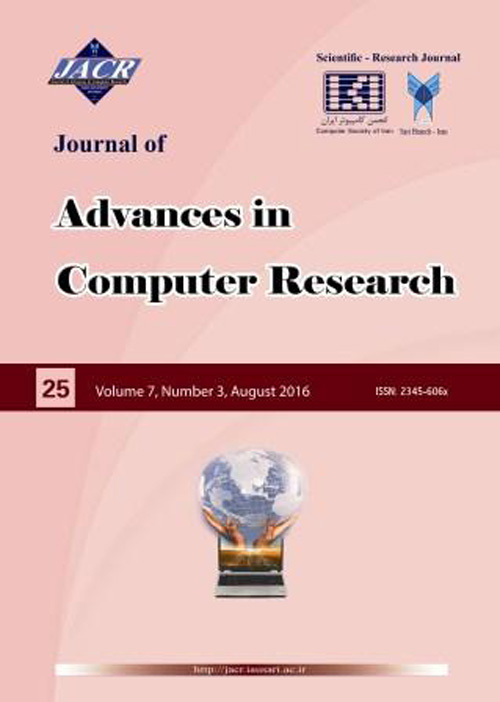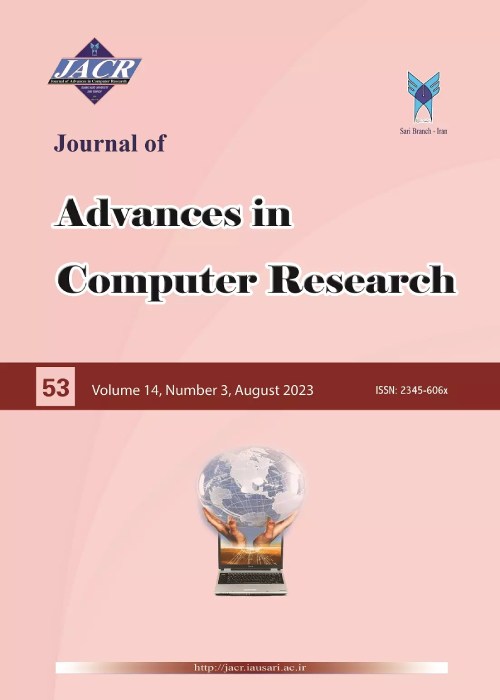فهرست مطالب

Journal of Advances in Computer Research
Volume:7 Issue: 3, Summer 2016
- تاریخ انتشار: 1395/06/27
- تعداد عناوین: 10
-
Pages 1-14Neural network is one of the most widely used algorithms in the field of machine learning, On the other hand, neural network training is a complicated and important process. Supervised learning needs to be organized to reach the goal as soon as possible. A supervised learning algorithm analyzes the training data and produces an inferred function, which can be used for mapping new examples. Hence, in this paper, it is attempted to use improve Stud GA to find optimal weights for multi-layer Perceptron neural network. Stud GA is improved from genetic algorithms that perform information sharing in a particular way. In this study, chaotic system will be used to improve Stud GA. The comparison of proposed method with Imperialist Competitive Algorithm, Quad Countries Algorithm, Stud GA, Cuckoo Optimization Algorithm and Chaotic Cuckoo Optimization Algorithm on tested data set (Wine, Abalone, Iris, WDBC, PIMA and Glass) with determined parameters, as mentioned the proposed method has a better performance.Keywords: Genetic Algorithms, Chaos Theory, Artificial neural networks, Evolutionary–Neural Network, Stud GA
-
Pages 15-32Exploiting multimodal information like acceleration and heart rate is a promising method to achieve human action recognition. A semi-supervised action recognition approach AUCC (Action Understanding with Combinational Classifier) using the diversity of base classifiers to create a high-quality ensemble for multimodal human action recognition is proposed in this paper. Furthermore, both labeled and unlabeled data are applied to obtain the diversity measure from multimodal human action recognition. Any classifiers can be applied by AUCC as its base classifier to create the human action recognition model, and the diversity of classifier ensemble is embedded in the error function of the model. The models error is decayed and back-propagated to the basic classifiers through each iteration. The basic classifiers weights are acquired during creation of the ensemble to guarantee the appropriate total accuracy of the model. Considerable experiments have been done during creation of the ensemble. Extensive experiments show the effectiveness of the offered method and suggest its superiority of exploiting multimodal signals.Keywords: Action Learning, Ensemble Learning, Machine Learning
-
Pages 33-45Session Initiation Protocol (SIP) is the main signaling protocol of next generation networks (NGN). SIP based applications are usually deployed over the Internet, for which their text-based nature and internal stateful operation make them vulnerable to different types of attacks. The real‑time functionality of SIP based applications make their related security systems more complex. On the other hand, automatic response to intrusions is one of the most important issues in securing different applications. The current state of intrusion detection systems (IDS) is that they often generate too many same or similar alerts for one intrusion which makes the function of response system unreliable. In this paper, we propose a security framework for automatic intrusion response in SIP environments. Our framework consists of specific firewall, detection engine and response part. The SIP firewall works based on URIs (universal reference identifier), and filters the incoming packets in the edge of network. Input packets are directed to the specification based detection engine which works based on the proposed exactly engineered features. The output of this system and the current state of the SIP proxy (e.g. call completion rate, call rejection rate and etc.) are fed to the response system to make a final decision. A prepared test bed is used for analyzing the performance of the proposed response system, measuring its performance using three distinct datasets. The experimental results show the performance of the proposed response system in terms of detection rates.Keywords: SIP IDS, flooding attacks, NGN, IMS security, Intrusion Response System
-
Pages 47-53We design and simulate a five-port optical router, which is composed of twenty Mach-Zehnder-based switching elements and twelve waveguide crossings for use in integrated photonic interconnection networks. We simulated and analyzed the operation of the proposed optical router from the aspects of insertion loss,power budget, Q-factor and the minimum bit error ratio by use of OptiSystem simulator. The simulation results show that twenty possible input/output routing paths of the five-port optical router are verified at a data transmission rate of 20 Gbps for all input-output channels.Keywords: Five, Port Optical Router, Mach, Zehnder Interferometer Switch, On, Chip Optical Interconnects, Optical Design, Photonic Network on Chip
-
Pages 55-66Scaling challenges and limitations of conventional silicon transistors have led the designers to apply novel nano-technologies. One of the most promising and possible nano-technologies is CNT (Carbon Nanotube) based transistors. CNFET have emerged as the more practicable and promising alternative device compared to the other nanotechnologies. This technology has higher efficiency compared to the silicon-based MOSFET and is appropriate for high-frequency applications. Full Adder cell is the essential core and the building block of most arithmetic circuits and is placed on most parts of their critical paths .In this paper, power-efficient CNFET (Carbon Nanotube Field Effect Transistor) based Full Adder cell is proposed. This design is simulated in several supply voltages, frequencies and load capacitors using HSPICE circuit simulator. Considerable improvement is achieved in terms of power and PDP (Power-Delay-Product) in comparison with other classical CNFET-based designs, in the literature. Our proposed Full Adder can also drive large load capacitance and works properly in low supply voltages.Keywords: Full Adder, CNFET, High Speed, Low Power, Power Delay Product
-
Pages 67-76This paper presents a new audio encryption algorithm based on permutation and residue number system. In the current approach, signal samples are combined with residue number system through permutation; therefore, a specific noise is generated. Then, the audio signal is combined with the noise, generated by the algorithm, to produce a silence signal. For this purpose, the algorithm uses a predefined permutation format and a modular set in the form of {2n-1, 2n, 2n} to encrypt the main signal. Consequently, the proposed algorithm converts the input signal into a silence signal and increases its security. The signal-to-noise ratio (SNR) was used to evaluate the algorithm. The results indicated very low values of SNR pertaining to audio signals in the proposed method.Keywords: Encryption, Decryption, SNR, Residue Number System, Audio Signal, Permutation
-
Pages 77-91The traveling salesman problem (TSP) is a well-known combinatorial optimization problem and holds a central place in logistics management. The TSP has received much attention because of its practical applications in industrial problems. Many exact, heuristic and metaheuristic approaches have been proposed to solve TSP in recent years. In this paper, a modified ant colony optimization (MACO) is presented which possesses a new strategy to update the increased pheromone, a candidate list and a mutation operation to solve the TSP. In addition, some local search algorithms are utilized as an effective criterion and only a global updating is used in order to increase pheromone on the edges of the best route. The proposed metaheuristic algorithm is tested on the well-known TSP instances involving 14 benchmark problems from 48 to 200 nodes. The computational results show that our algorithm is better than other meta-heuristic algorithms in terms of solution quality. Furthermore, the gap of the proposed algorithm stays on average almost 1% of the execution time and also the most best known solutions of the benchmark problems are found.Keywords: Traveling Salesman Problem, Ant Colony Optimization, Global Updating, NP, hard Problems
-
Pages 93-103Mobile-Ad-Hoc-Networks (MANETs) are self-configuring networks of mobile nodes, which communicate through wireless links. The infrastructure of a Mobile Ad hoc Network (MANET) has no routers for routing, and all nodes must share the same routing protocol to assist each other when transmitting messages. The main issues in MANETs include the mobility of the network nodes, the scarcity of computational, bandwidth and energy resources. The routing is particularly a challenging task in MANETs that selecting paths in a network along which to send network traffic. Thus, Mobile Ad hoc Network (MANET) routing protocols should explicitly consider network changes and node changes in their operations. In this paper we present a novel routing algorithm for mobile ad hoc networks.It employs both reactive and proactiveschemes in its design. Simulation results show that our protocol can outperform AODV, AOMDV and DSDV protocols in terms of, packet delivery ratio, packet loss and throughput.Keywords: MANETs, Routing, Multi Agent, Multi Objective
-
Pages 105-130This paper presents a new damping controller design based on fuzzy wavelet neural network (FWNN) to damp the multi-machine power system low frequency oscillations. The error between the desired system output and the output of control object is directly utilized to tune the network parameters. The orthogonal least square (OLS) algorithm is used to purify the wavelets for each rule and determine the number of fuzzy rules and network dimension. In this paper, Shuffled Frog Leaping Algorithm (SFLA) is proposed for learning of FWNN and to find the optimal values of the parameters of the FWNN damping controller. To illustrate the capability of the proposed approach, some numerical results are presented on a 2-area 4-machine and a 5-area-16-machine power system. To show the effectiveness and robustness of the designed controller, the case studies are tested under two conditions: applying a line-to-ground fault at a bus and applying a three phase fault at a bus. Furthermore, to make a comparison, the proposed approach is compared with a classical based method and a FWNN based genetic algorithm approach, which is adopted from literature, through eigenvalue analysis, time- domain simulation and some performance indices. The simulation results show the superiority and capability of the proposed FWNN damping controller.Keywords: Fuzzy Wavelet Neural Network, Shuffled Frog Leaping Algorithm, Low Frequency Oscillations, Damping Controller
-
Pages 131-142Multiple Traveling Salesman Problem (MTSP) is one of the most popular operation research problem and is known as combinatorial optimization problems. MTSP is an extension version of the famous and widely used problem named Traveling Salesman Problem (TSP). Because of its benefices in various domains, many researchers have tried to solve that, and many methods have proposed so far. MTSP is a NP-complete problem so deterministic algorithms arent able to solve it in a reasonable time and in most cases heuristic methods are used. We propose a combination algorithm named at HGELS to solve MTSP in this paper. Our aim is to minimize the distance traveled by salesman and also the cost of path traveling. In fact, the proposed algorithm aims to balance the cost of path and distance. Experimental results indicate that the proposed algorithm needs more time to run than other algorithms, but in most cases has obtained better results.Keywords: MTSP, Optimization, Genetic Algorithm, GELS Algorithm


